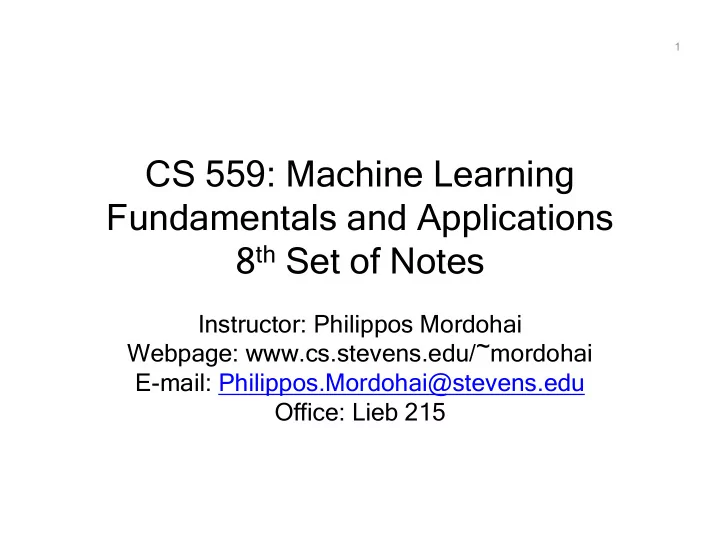

1 CS 559: Machine Learning Fundamentals and Applications 8 th Set of Notes Instructor: Philippos Mordohai Webpage: www.cs.stevens.edu/~mordohai E-mail: Philippos.Mordohai@stevens.edu Office: Lieb 215
Project Proposal • Dataset – How many instances • Classes (or what is being predicted) • Inputs – Include feature extraction, if needed – If your inputs are images or financial data, this must be addressed • Methods – At least one simple classifier (MLE with Gaussian model, Naïve Bayes, kNN) – At least one advanced classifier (SVM, Boosting, Random Forest, CNN) 2
Project Proposal • Typical experiments – Measure benefits due to advanced classifier compared to simple classifier – Compare different classifier settings • k in kNN • Different SVM kernels • AdaBoost vs. cascade • Different CNN architectures – Measure effects of amount of training data available – Evaluate accuracy as a function of the degree of dimensionality reduction using PCA 3
Project Proposal • Email me a pdf with all these • I must say “approved” in my response, otherwise address my comments and resubmit 4
Overview • Linear Regression – Barber Ch. 17 – HTF Ch. 3 5
Simple Linear Regression • How does a single variable of interest relate to another (single) variable? – Y = outcome variable (response, dependent...) – X = explanatory variable (predictor, feature, independent...) • Data: n pairs of continuous observations (X 1 ,Y 1 ) … (X n ,Y n ) 6
Example • How does systolic blood pressure (SBP) relate to age? • Graph suggests that Y relates to X in an approximately linear way 7
Regression: Step by Step 1. Assume a linear model: Y = β 0 + β 1 X 2. Find the line which “best” fits the data, i.e. estimate parameters β 0 and β 1 3. Does variation in X help describe variation in Y ? 4. Check assumptions of model 5. Draw inferences and make predictions 8
Straight-line Plots 9
Assumptions of Linear Regression • Five basic assumptions 1. Existence: for each fixed value of X, Y is a random variable with finite mean and variance 2. Independence: the set of Y i are independent random variables given X i 10
Assumptions of Linear Regression 3. Linearity: the mean value of Y is a linear function of X �|� � � 11
Assumptions of Linear Regression 4. Homoscedasticity: the variance of Y is the same for any X 5. Normality: For each fixed value of X, Y has a normal distribution (by assumption 4, σ 2 does not depend on X) 12
Formulation • Y i are linear function of X i plus some random error 13
Linear Regression 14
Estimating β 0 and β 1 • Find “best” line • Criterion for “best”: estimate β 0 and β 1 to minimize: • This is the residual sum of squares, sum of squares due to error, or sum of squares about regression line • Least Squares estimator 15
Rationale for LS Estimates 2 measures the “deviance” of Y i from the • estimated model • The “best” model is the one from which the data deviate the least 16
Least Squares Estimators • Taking derivatives with respect to β , we obtain • The residual variance is 17
Example: SBP/age data 18
Using the Model • Using the parameter estimates, our best guess for any Y given X is • Hence at • Every regression line goes through ( , ) • Also 19
Correlation and Regression Coefficient 20
Example 21
Example 22
Example 23
Example 24
Recommend
More recommend